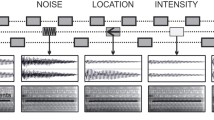Abstract
This study aims to evaluate physiological and psychological states using near infrared spectroscopy in noise environments with low or high frequencies. Our system assumes that noise affects brain activity in the frontal lobe. In order to evaluate the subject’s states in a noise environment, we constructed an experimental system that measures the subject’s states. The experimental method adopted here was borrowed from our previous studies. In the present study, we collected experimental data about the subject’s unpleasant or pleasant experiences by producing a noise environment with low and high frequencies. We conclude that noises with low or high frequencies affect our psychological states as well as brain activity in the frontal lobe.














Similar content being viewed by others
Explore related subjects
Discover the latest articles, news and stories from top researchers in related subjects.References
Hashimoto Y, Nishioka T, Umemiya N, Okura R (2003) The Effects of Traffic Noise an EEG Approach. J Environ Eng 570:1–6
Yoshida T (1991) Road traffic noise and health of inhabitants. Collect Acad Lect Outl D Environ Eng 1991:451–452
Stevenson DC, Mckellar NR (1989) The effect of traffic noise on sleep of young adults in their house. J Acoust Soc Am 85(2):768–771
Knall V, Schuemer R (1983) The differing annoyance levels of rail and road traffic noise. J Sound Vib 87(2):321–326
Vernet M (1983) Comparison between train noise and road noise annoyance during sleep. J Sound Vib 87(2):331–335
Nishina E, Oohashi T (2005) Study on the improvement of urban sound environment by the sound with in-audible high frequency components-Interdisciplinary approach using electroencephalogram. Physiologically active substances and subjective evaluation. J City Plann Inst Jpn 40(3):169–174
Ohashi R (2004) Sound and civilization. Iwanami Shoten (in Japanese)
Koyasu M (1990) Recent developments in the measurements of noise and vibration. J Acoust Soc Jpn 46(5):427–432
Architectural Institute of Japan (1981) The evaluation method with noise. Shokokusha
Yanagisawa K, Tsunashima H, Marumo Y, Hirose S, Shimizu T, Taira M (2009) Measurement and evaluation of higher brain function using functional near-infrared spectroscopy (fNIRS), human interface. Trans Hum Interface Soc 11(2):183–192
Osawa T, Asano H, Ide H (2010) Brain activity evaluation using oxy-Hb by difference in strength of sound stimulus. IEEJ D 130(9):1108–1112
Ministry of the Environment (2000) The manual about the measuring method of a low frequency vibration
Chuden engineering consultants (2012) The examination research service report about the noise and the low frequency vibration of a wind power generation institution
Nishina E, Yagi R, Fuwamoto Y, Kawai N, Morimoto M, Sanada K, Oohashi T (1996) Study on the power spectra of environmental sound in the trains and the station precincts. Archit Inst Jpn 1996:1–2
Kiryu S, Shimatani Y, Ashihara K (2011) A trial of physiologic measurements of auditory thresholds for high frequency sounds. Acoust Soc Jpn 67(5):204–207
Japan Society of Physiological Anthropology (1996) Human science measurement handbook, Gihodo shuppan
Murakami N (2006) How to build a mental measure. Kitaooji shobo publishing
Susumu U, Hirotoshi A, Hideto I (2010) Physiological psychological evaluation of strength of auditory stimulus. IEEJ Trans IA 130(11):1199–1204
Sawada Y, Hirahara T (2009) Spectral features that cause unpleasantness of absolutely unpleasant sound. Tech Rep IEICE 109(240):25–29
Author information
Authors and Affiliations
Corresponding author
About this article
Cite this article
Osawa, T., Asano, H., Mizuno, T. et al. Physiological and psychological evaluations in low- and high-frequency noise using near-infrared spectroscopy. Artif Life Robotics 21, 5–10 (2016). https://doi.org/10.1007/s10015-015-0249-2
Received:
Accepted:
Published:
Issue Date:
DOI: https://doi.org/10.1007/s10015-015-0249-2




